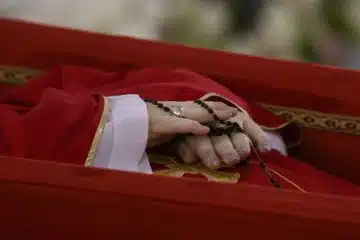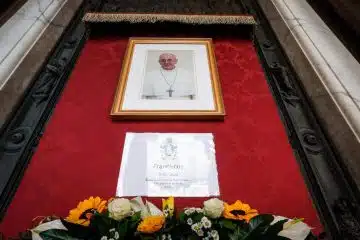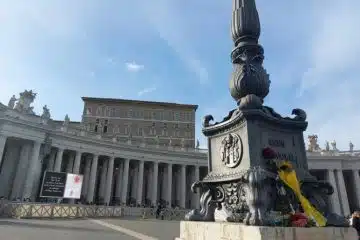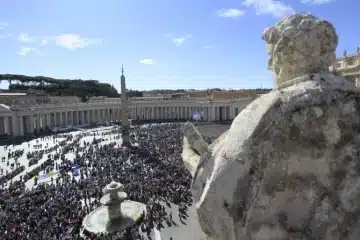Rebuilding in Ecuador after April quake complicated by enduring poverty

IMAGE: CNS photo/Barbara Fraser
By Barbara J. Fraser
JAMA, Ecuador (CNS) — Ask Jose Santos about the earthquake that struck the northern coast of Ecuador in April and he paints a vivid picture.
“The ground moved like waves on the ocean,” he recalls, while a pall of sulfurous-smelling haze rose over the town.
Santos’ welding shop collapsed, destroying the tools on which he depended for a livelihood. At his home in the village of Bigua, a few miles away, his wife and their children fled their house as the walls cracked.
After the quake, they slept outdoors, afraid that one of the more than 150 aftershocks might bring the house down. Now, they and nearly 80 neighbors have temporary homes in 10- by 20-foot tents donated by the Catholic Church.
Four months after the April 16 earthquake — which killed more than 670 people, injured nearly 5,000 and left as many as 80,000 homeless — residents of northern Ecuador are slowly rebuilding. But the disaster exposed long-standing problems that will take longer to solve, especially in rural areas.
“People speak of before and after 16-A,” says Alfredo de la Fuente, director of social ministry for Caritas Ecuador in the Archdiocese of Portoviejo. “It changed the lives of the vast majority of people” in the northern coastal provinces of Manabi and Esmeraldas.
In Jama and other towns in the hardest-hit area, aerial photos showed the devastation of collapsed buildings in the days after the quake. The rubble is gone now, leaving urban areas dotted with vacant lots.
“But the damage is far worse than it appears,” de la Fuente says, because some of the remaining buildings will have to be demolished, while others will need extensive repairs.
“Recovery will be very slow,” he says.
Some people who lost their homes moved in with relatives, while others sought refuge in shelters set up by the government.
Government teams began going house to house, assessing damage and rating buildings with a stoplight system. A green tag means the house is habitable, yellow means it needs repairs, and red tags mark houses that are condemned. The inspection takes time but is required if a family is to qualify for a reconstruction loan.
Many of the earthquake victims who are suffering most are those in rural areas, farthest from the view of cameras, church workers say.
Immediately after the earthquake, Caritas provided food, water, coffins and large tents, with support from Catholic Relief Services, the humanitarian aid and development agency of the U.S. Conference of Catholic Bishops.
Both agencies also began their own assessment in rural areas. Social ministry teams have visited about 1,400 families, says Joseph Kelly, CRS program director for Latin America.
“The earthquake exposed a situation that was already precarious in a lot of these communities,” Kelly says. “Water systems were decrepit, and communities were already suffering from water-borne diseases. People had to buy water from a truck or boil river water.”
The social ministry teams evaluate housing damage, provide hygiene kits and show people how to disinfect water and store it safely.
Standing water provides a breeding ground for mosquitoes that carry tropical diseases such as dengue, chikungunya and zika. A disaster like the earthquake raises the risk of an outbreak that would further strain emergency workers, says Oscar Robles, who heads CRS’ disaster response.
The Caritas teams also offer moral support, assuring families that they are not forgotten, de la Fuente says. And they keep an eye out for stress-related psychological problems, such as domestic violence.
As an alternative to cramped, multi-family shelters — and to enable families to remain on their property — Caritas and CRS have built more than 850 temporary shelters, stretching tarps over sturdy bamboo frames. Most have a latrine and a small, three-sided structure with a concrete floor where the family can take bucket baths, as most houses lack running water.
CRS has invested about $4 million so far, and expects to provide earthquake recovery assistance for about 12 months, Kelly says. Besides meeting immediate needs, the agency is working with municipal water providers to repair and upgrade damaged systems.
The earthquake was as much an economic shock as a seismic jolt. The scenic coastal fishing villages of Manabi and Esmeraldas, with their placid beaches, are a popular tourist destination.
This year, however, visitors are scarce. CRS opened its disaster relief headquarters in the only hotel still operating in Jama, which was empty after the quake. The disaster also has depressed the fishing industry because many restaurants are empty or closed.
In cities such as Portoviejo and Manta, Caritas is helping women form solidarity groups with revolving funds that they can use to start small businesses.
Psychological scars may be slower to heal. In Bigua, some people still go indoors only to cook, even if their homes suffered little damage.
Alicia Nevares, 65, recalls sleepless nights as aftershocks jolted the region. She is afraid to return to her home with her husband, who has Parkinson’s disease, preferring the tent just across the street.
Farther north, in Esmeraldas, where many people live on an island just off the coast, a strong aftershock triggered a new rush to the mainland. With no bridge connecting the island, the only transportation is by boat.
Government officials have proposed resettling the islanders on the mainland, but they are reluctant to move permanently.
Nevertheless, signs of recovery are evident. Townspeople have cleared the debris of collapsed shops and operate their businesses out of tents.
In a place where jobs were already scarce, “people cannot afford to wait,” Robles says. “The impact of the earthquake was great, because the country didn’t have much experience with a disaster like this, but people have a strong will to keep forging ahead.”
– – –
Copyright © 2016 Catholic News Service/U.S. Conference of Catholic Bishops. www.catholicnews.com. All rights reserved. Republishing or redistributing of CNS content, including by framing or similar means without prior permission, is prohibited. You may link to stories on our public site. This copy is for your personal, non-commercial use only. To request permission for republishing or redistributing of CNS content, please contact permissions at [email protected].













